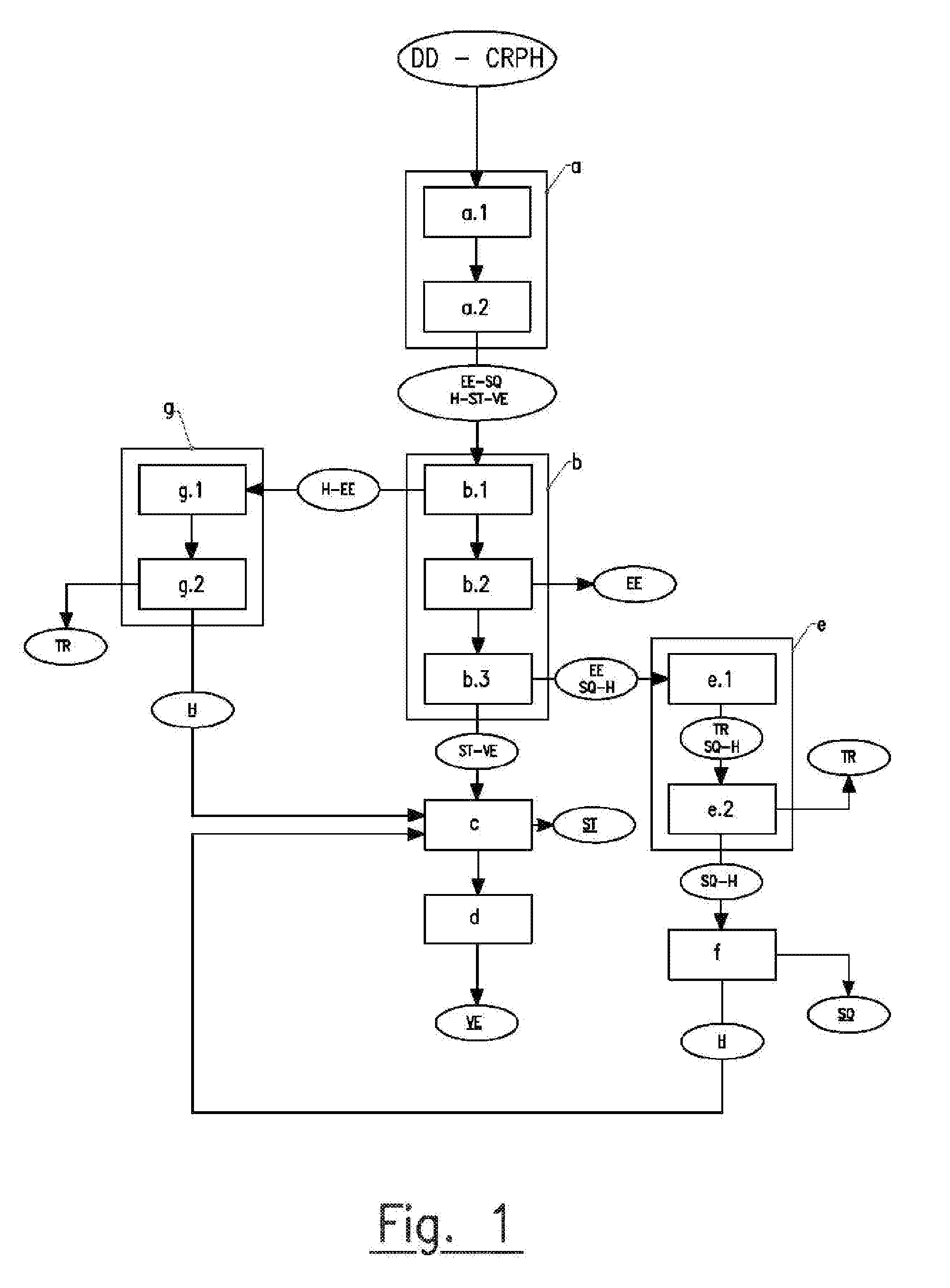Process for the extraction of squalene, sterols and vitamin e contained in condensates of physical refining and/or in distillates of deodorization of plant oils
a technology of squalene and sterols, which is applied in the direction of fatty-oil/fat refining, separation processes, and metabolic disorders, etc., can solve the problems of large portion of squalene loss during distillation, uneconomical reasonable extraction of these families of unsaponifiables directly from vegetable oils, and appreciable concentration of unsaponifiables in dds or oprcs of vegetable oils
- Summary
- Abstract
- Description
- Claims
- Application Information
AI Technical Summary
Benefits of technology
Problems solved by technology
Method used
Image
Examples
example 1
Esterification by Bio-Ethanol of a Deodorization Distillate of Sunflower Oil—Step a)
[0096]In a 5 liter flask, 1,000 g of oleic sunflower DD is introduced, which has the following composition:[0097]saponifiable portion: free fatty acids: 38%, triglycerides: 25.8%, fatty acid esters: 7%;[0098]unsaponifiable portion: 29.2%. This unsaponifiable portion consists of sterols and triterpene alcohols for 38.6%, squalene: 19.9%, vitamin E: 6.5%, non-squalene hydrocarbons: 29.8%, unidentified products and impurities: 5.2%.
[0099]This condensate is mixed with 620 grams of anhydrous ethanol i.e. a molar ethanol excess relatively to the fatty acids of 10. 1 gram of concentrated sulfuric acid is added, i.e. 0.1% relatively to the mass of loaded condensate. The stirred flask is purged several times with nitrogen and then heated to 90° C. The reaction is conducted for 4 hours with reflux of ethanol. After cooling, the sulfuric acid is neutralized with a 0.5 N ethanolic soda solution with stirring, fo...
example 2
Esterification by Bio-Ethanol of a Sunflower DD—Step a)
[0100]500 g of sunflower DD identical with those of Example 1 are introduced into a 1-liter autoclave. This condensate is mixed with 154.9 grams of anhydrous bio-ethanol, i.e. a molar ethanol / fatty acids excess of 5. 0.5 g of concentrated sulfuric acid are added, i.e. 0.1% relatively to the mass of loaded condensate. After several purges with nitrogen, the reactor is gradually heated to 90° C., with stirring for one hour, the pressure reached being 2.5 bars. After cooling the reactor, the reaction medium is neutralized with a 0.5 N ethanolic soda solution, for 30 minutes with stirring. The ethanol is then distilled at atmospheric pressure and then in a vacuum of 50 mbars and at a temperature of 100° C. at the end of the distillation, in order to remove the esterification water. An anhydrous product is obtained with an acid number of 0.8 and the squalene was not isomerized.
example 3
Ethanolysis of a Sunflower DD Esterified with Bio-Ethanol—Step a)
[0101]In a 5-liter flask, 1,000 grams of the esterified product in the example 1 are introduced, which contain 25.8% of triglycerides and 11.2% of sterols present in an esterified form, which corresponds to 1 mole of ester. 20 moles of anhydrous bio-ethanol (molar excess of 20) i.e. 920 grams of bio-ethanol are added, in which 1% by weight of sodium has been dissolved beforehand in order to generate sodium alcoholate in situ. The flask is then heated with stirring, with reflux of ethanol, to 80° C., for 2 hours. The sodium present in the form of sodium ethylate is then neutralized with a 0.5 N sulfuric acid solution. The ethanol is first distilled under atmospheric pressure, and then under a reduced pressure of 50 mbars. The sodium sulfate formed during neutralization is removed by washing with water. All the glycerides were converted into ethyl esters as well as the pre-existing sterides, which causes effective releas...
PUM
| Property | Measurement | Unit |
|---|---|---|
| Temperature | aaaaa | aaaaa |
| Temperature | aaaaa | aaaaa |
| Temperature | aaaaa | aaaaa |
Abstract
Description
Claims
Application Information
 Login to View More
Login to View More - R&D
- Intellectual Property
- Life Sciences
- Materials
- Tech Scout
- Unparalleled Data Quality
- Higher Quality Content
- 60% Fewer Hallucinations
Browse by: Latest US Patents, China's latest patents, Technical Efficacy Thesaurus, Application Domain, Technology Topic, Popular Technical Reports.
© 2025 PatSnap. All rights reserved.Legal|Privacy policy|Modern Slavery Act Transparency Statement|Sitemap|About US| Contact US: help@patsnap.com

